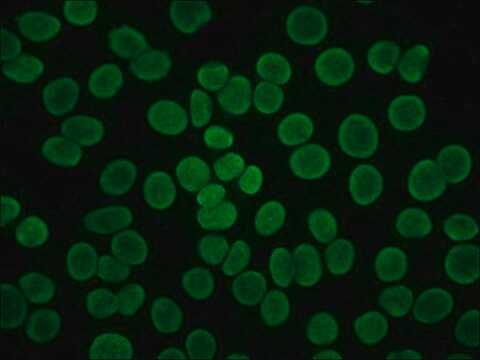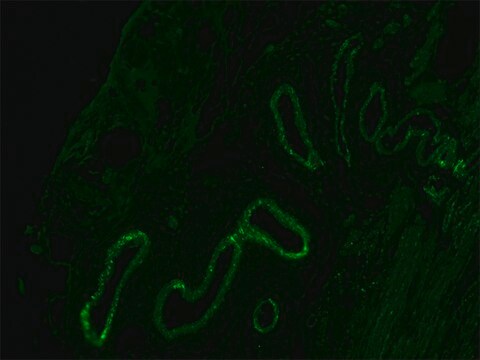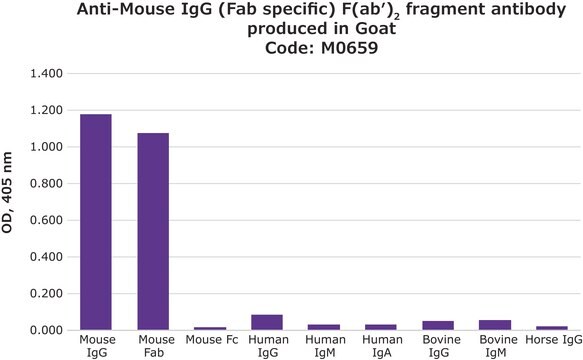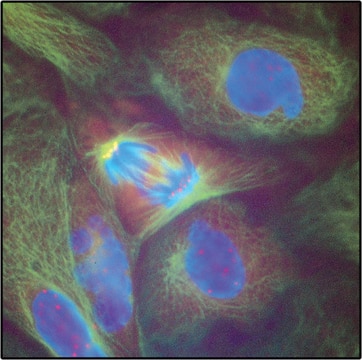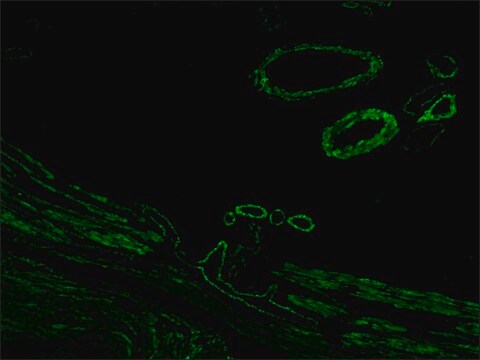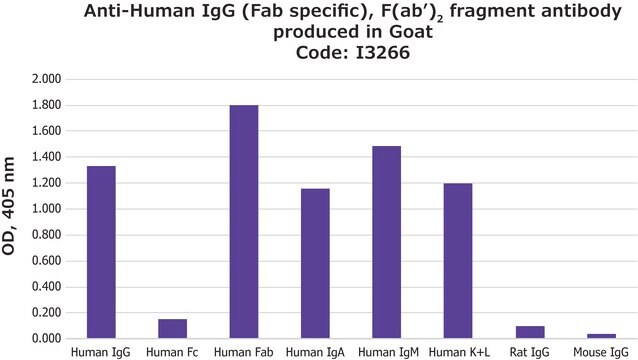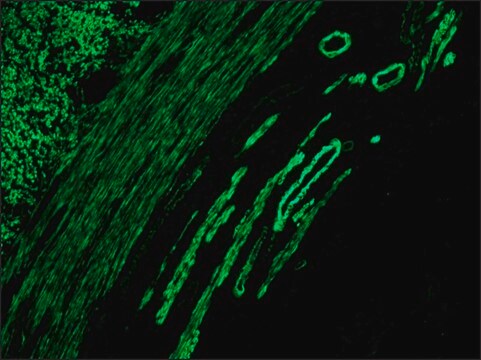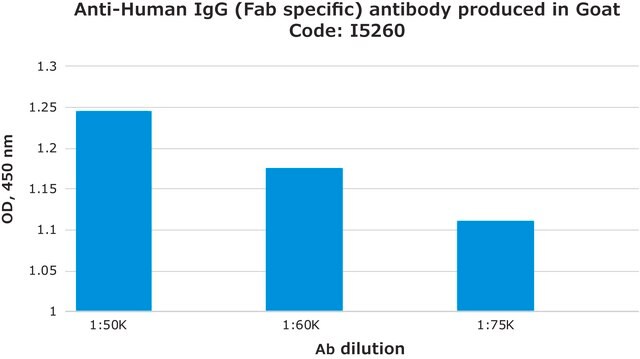F2653
Anti-Mouse IgG (Fab specific) F(ab′)2 fragment–FITC antibody produced in goat
affinity isolated antibody, buffered aqueous solution
Sign Into View Organizational & Contract Pricing
All Photos(1)
About This Item
Recommended Products
biological source
goat
conjugate
FITC conjugate
antibody form
affinity isolated antibody
antibody product type
secondary antibodies
clone
polyclonal
form
buffered aqueous solution
technique(s)
flow cytometry: 1:100
immunohistochemistry (formalin-fixed, paraffin-embedded sections): 1:160
storage temp.
−20°C
target post-translational modification
unmodified
Looking for similar products? Visit Product Comparison Guide
General description
IgG, a monomer, is the principal antibody circulating in blood which assist in phagocytic destruction of foreign microorganism and is the only class of Ig that can cross the placenta in humans. Cell-sorting done by differential binding of anti-mouse IgG (Fab Specific) - FITC antibody separates tumour cells from macrophages. This antibody can be used to incubate somatic cell nuclear transfer (SCNT) rat embryos for immunocytochemical observation. It also can be used as a secondary antibody to study the dynamics of activated B lymphocytes in small intestine, Peyer′s patch germinal center as well as non-germinal center, spleen and the mesenteric lymph node. Anti-mouse IgG antibody reacts specifically with all mouse immunoglobulins.
Immunoglobulin G (IgG) belongs to the immunoglobulin family and is a widely expressed serum antibody. An immunoglobulin has two heavy chains and two light chains connected by a disulfide bond. It mainly helps in immune defense. It is a glycoprotein. IgG is a major class of immunoglobulin. Mouse consists of five immunoglobulin classes- IgM, IgG, IgA, IgD and IgE. Mouse IgG is further divided into five classes- IgG1, IgG2a, IgG2b and IgG3.
Specificity
Binds all mouse Igs.
Useful when trying to avoid background staining due to the presence of Fc receptors.
Useful when trying to avoid background staining due to the presence of Fc receptors.
Immunogen
Purified Fab fragments of mouse IgG.
Application
Anti-Mouse IgG (Fab Specific) FITC Conjugate antibody is used in traditional method of immunocytochemical assessment of ZAP-70 expression. It can also be used in immunocytochemical observation of the SCNT embryos.
Anti-Mouse IgG (Fab specific) F(ab′)2 fragment-FITC antibody produced in goat has been used in:
- indirect immunofluorescence staining
- immunofluorescence staining
- flow cytometry
Applications in which this antibody has been used successfully, and the associated peer-reviewed papers, are given below.
Flow cytometry/Cell sorting (1 paper)
Flow cytometry/Cell sorting (1 paper)
Biochem/physiol Actions
Immunoglobulin G (IgG) participates in hypersensitivity type II and type III reactions. IgG helps in opsonization, complement fixation and antibody dependent cell mediated cytotoxicity.
Other Notes
Antibody adsorbed with bovine, equine and human serum proteins.
Physical form
Solution in 0.01 M phosphate buffered saline, pH 7.4, containing 1% bovine serum albumin and 15 mM sodium azide.
Preparation Note
Adsorbed to reduce background staining with bovine, horse or human samples.
Disclaimer
Unless otherwise stated in our catalog or other company documentation accompanying the product(s), our products are intended for research use only and are not to be used for any other purpose, which includes but is not limited to, unauthorized commercial uses, in vitro diagnostic uses, ex vivo or in vivo therapeutic uses or any type of consumption or application to humans or animals.
Not finding the right product?
Try our Product Selector Tool.
Storage Class Code
10 - Combustible liquids
WGK
nwg
Flash Point(F)
Not applicable
Flash Point(C)
Not applicable
Personal Protective Equipment
dust mask type N95 (US), Eyeshields, Gloves
Choose from one of the most recent versions:
Already Own This Product?
Find documentation for the products that you have recently purchased in the Document Library.
Customers Also Viewed
Agnieszka Bojarska-Junak et al.
Folia histochemica et cytobiologica, 43(1), 19-23 (2005-05-06)
The ZAP-70 protein is a member of the Syk/ZAP protein tyrosine kinase family, normally expressed in T cells and NK cells but not found in normal, mature B cells. The protein plays a critical role in the initiation of T-cell
Gert J Ossenkoppele et al.
British journal of haematology, 162(2), 191-201 (2013-05-08)
Tefinostat (CHR-2845) is a monocyte/macrophage targeted histone deacetylase inhibitor (HDACi). This first-in-human, standard 3 + 3 dose escalating trial of oral, once daily tefinostat was conducted to determine the safety, tolerability, pharmacokinetic and pharmacodynamic profile of tefinostat in relapsed/refractory haematological
Xiaobing He et al.
Stem cells (Dayton, Ohio), 27(7), 1487-1495 (2009-06-23)
Highly tumorigenic cancer cell (HTC) populations have been identified for a variety of solid tumors and assigned stem cell properties. Strategies for identifying HTCs in solid tumors have been primarily empirical rather than rational, particularly in epithelial tumors, which are
The Immunoglobulins: Structure and Function (1998)
C Trollet et al.
Infection and immunity, 77(5), 2221-2229 (2009-02-25)
Botulinum neurotoxins are known to be among the most toxic known substances. They produce severe paralysis by preventing the release of acetylcholine at the neuromuscular junction. Thus, new strategies for efficient production of safe and effective anti-botulinum neurotoxin antisera have
Our team of scientists has experience in all areas of research including Life Science, Material Science, Chemical Synthesis, Chromatography, Analytical and many others.
Contact Technical Service
